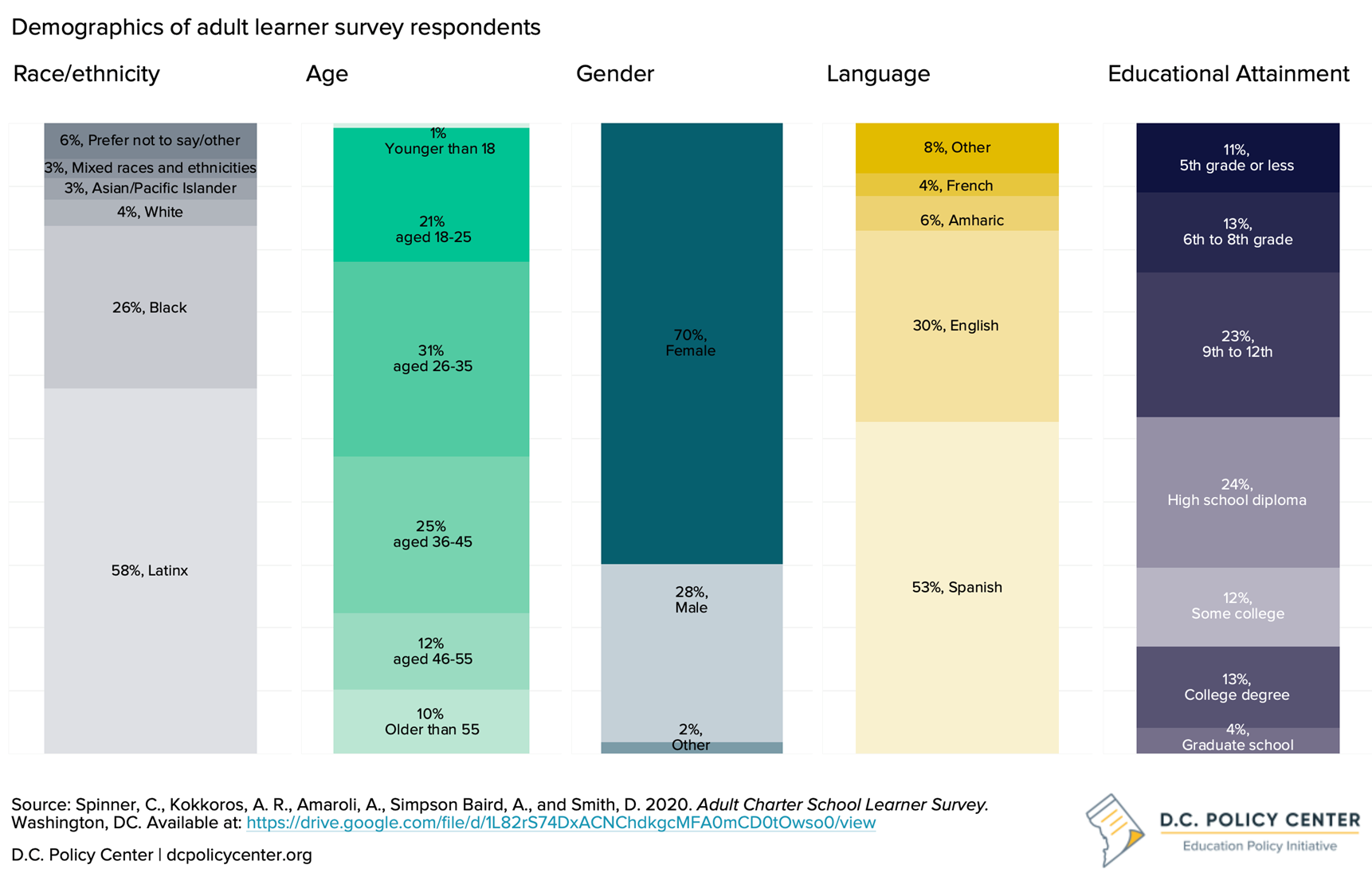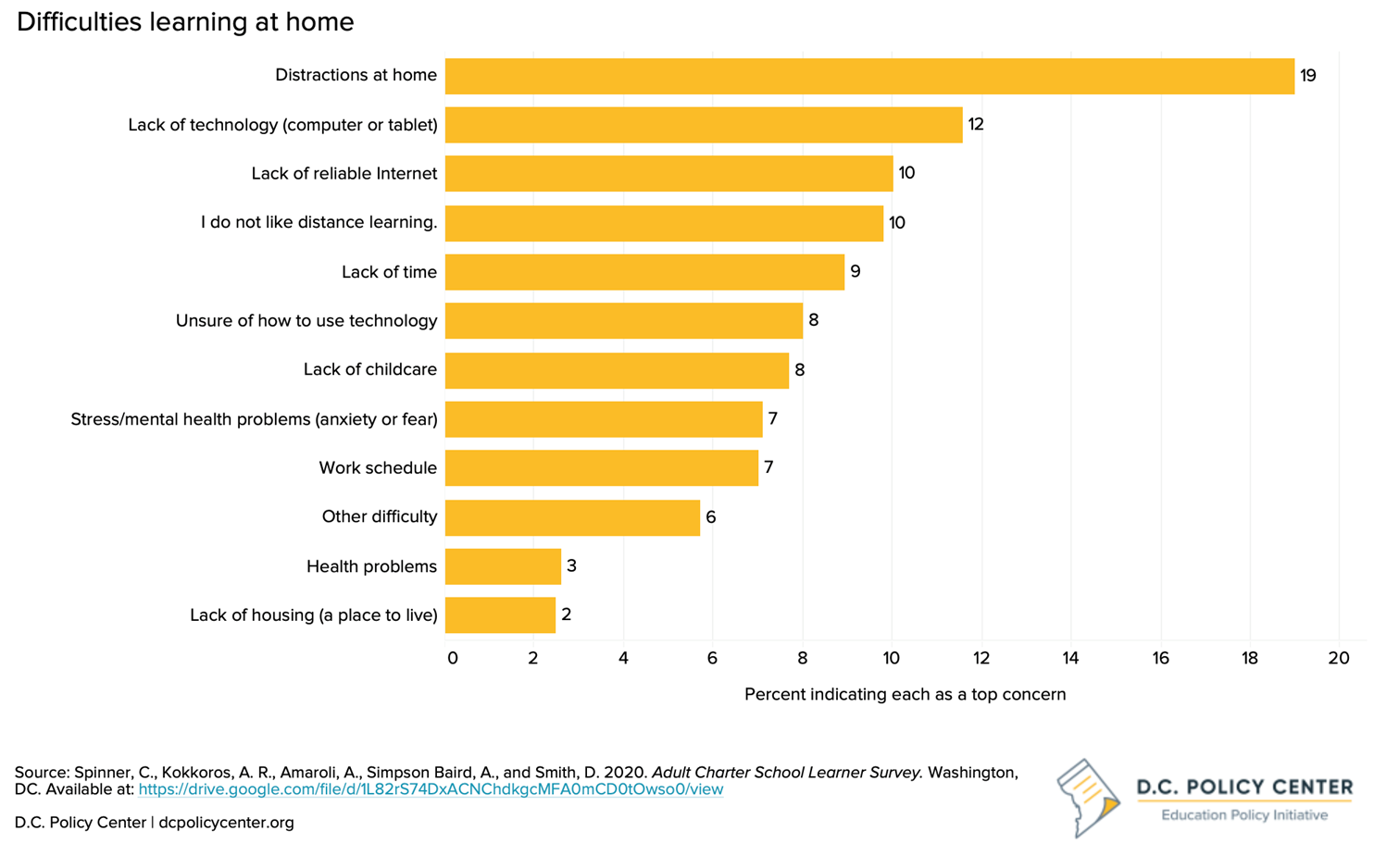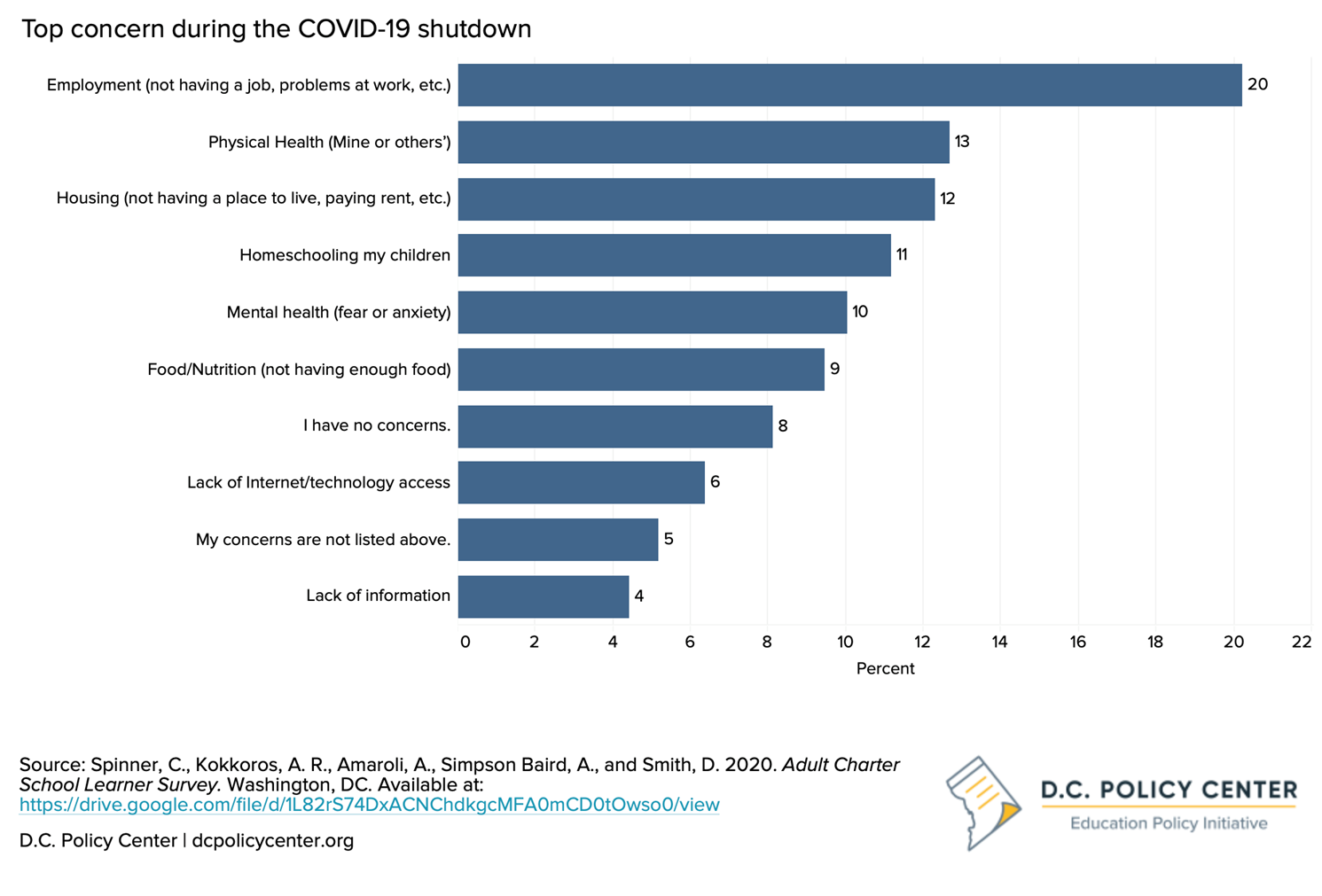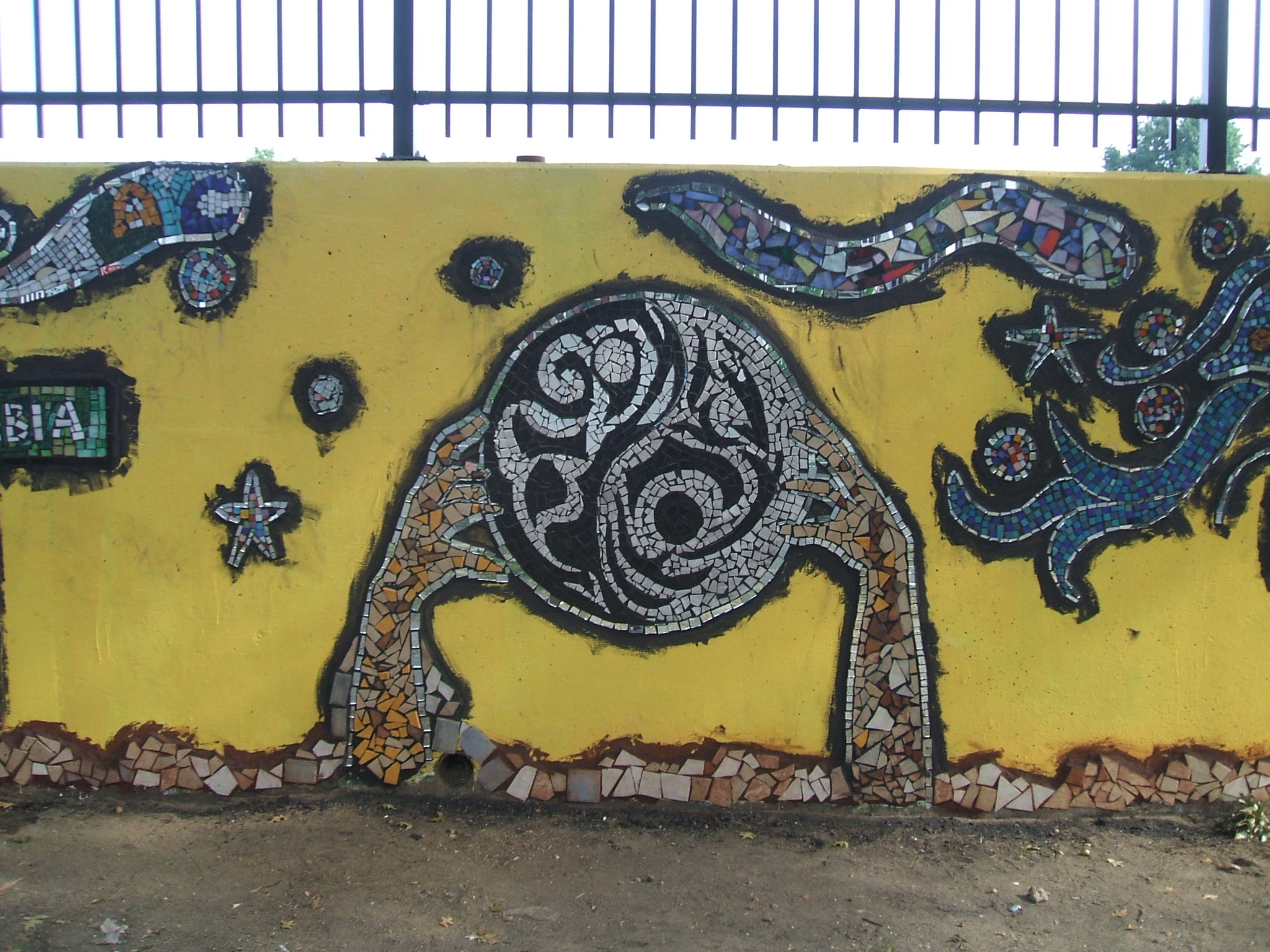
This article was written by Ashley Simpson Baird, Ph.D., founder and principal of Merit Research, Policy, and Evaluation which provides customized, equity-focused solutions for schools and educational non-profits.
Washington, D.C. is one of the highest-earning, most educated cities in the country, yet almost 20 percent of families with children under 18 live below the poverty line and 45,000 adult residents do not have a high school diploma. Adult-serving public charter schools in D.C. reduce these disparities by working with adult learners to put them on a path toward economic prosperity.
There are nine public charter schools in D.C. that offer educational programming for adults, and that high concentration makes D.C. unique. In fact, more than 10 percent of adult charter schools in the U.S. are located in the District (comparatively, elementary, middle, and high schools in D.C. make up less than 0.2 percent of schools nationally[1]). This high number of adult charters is due to both robust public funding for adult education as well as the D.C. Public Charter School Board, which supports a rigorous charter application process.
Adult charter schools in D.C. educate more than 5,000 students annually, offering a wide variety of educational programs, including workforce credentials, GED preparation, English as Second Language (ESL), U.S. Citizenship, and high school diploma courses. Not only do adult charters provide educational services, they also work with students to reduce barriers that may hinder their full participation in learning by providing social services, counseling, parenting classes, and referrals to partner organizations. Since 1996, the year the city’s first adult charter school opened, adult learners have gone on to complete postsecondary education, open businesses, be active in their communities, and provide for their families. These results speak for themselves in demonstrating the value of adult charter schools in D.C.
In March 2020, all schools in D.C., including adult charters, quickly pivoted to distance learning. Schools used a variety of formats to continue teaching and learning; these included conducting classes in Zoom sessions, recording video lessons for students to complete on their own, and providing hard copies of work for students to complete individually. For adult charter schools, this was a sudden and abrupt shift. Adult learners not only needed to navigate their own distance learning, many also needed to manage their children’s learning, all while navigating the new realities of the pandemic. Two months after transitioning to distance learning, adult charter schools conducted a citywide survey to better understand how the pandemic was impacting their students.
In May 2020, a team of researchers and data analysts representing three adult charter schools designed a survey with input from all nine schools. The survey team developed the instrument in Google Forms and delivered the survey in the four most widely spoken languages – English, Spanish, French, and Amharic. The survey contained 21 questions with six branching questions specifically for parents. From May 18-29, 2020, schools shared the survey with students via Email, text message, and phone calls, where staff completed the survey for students over the phone. Adult charter schools in D.C. plan to administer a similar survey towards the end of the fall 2020 semester in order to better understand the long-term impacts of the pandemic and how adult learners have adjusted to online learning. Results of the Citywide Adult Education Survey enumerate the challenges that adult learners face as well as how they persevere.
Adult learner demographics
Of the 3,486 students who received the Citywide Adult Education Survey, 1,832 submitted responses, a 53 percent response rate. Respondents represented seven[2] different charter schools and live in all eight wards of the city. The majority of respondents (53 percent) were younger than 35 years old and identified as female (70 percent).
More than 92 percent of survey respondents were people of color, including 58 percent Latinx and 26 percent Black, compared to 44 percent of adult education students who were Black and 52 percent who were Latinx in 2019.[3] The COVID-19 crisis has had disproportionate health and economic impacts on the communities that many adult charters serve, as communities of color are more likely to contract the virus. Black residents make up 52 percent of cases and 75 percent of deaths while representing only 47 percent of the city’s residents. Similarly, Latinx individuals encompass 29 percent of cases and 13 percent of deaths while representing only 11 percent of residents.
Respondents primarily speak seven home languages – Spanish (53 percent), English (30 percent), Amharic (6 percent), French (4 percent), Arabic (1 percent), Vietnamese (1. percent), and Chinese (0.6 percent). Adult charter schools also continue to play a key role in facilitating communication for families in D.C. They often have staff that speak families’ home languages and are versed in communicating with adults who may have low-literacy and/or be unfamiliar with public education in the U.S.

The survey also asked how students travel to school. Sixty-six percent of learners indicated that they use public transportation (i.e., bus or Metro), 17 percent said that they walk or ride a bicycle, while 12 percent used a personal vehicle. As some D.C. P12 schools consider a return to in-person learning, adult schools must also consider whether students will feel safe traveling to school since two-thirds of learners use public transportation.
Education and distance learning
During the spring of 2020, adult charter schools provided more than 800 individual devices (i.e., tablets, computers) and Wi-Fi connectivity to adult learners to enable distance learning. Adult charter schools also continued to provide wraparound supports for students, and many schools reported not only a greater need for these supports, but also additional challenges in providing them at a distance. Adult charter schools also supported parents who were overseeing their children’s distance learning by helping them navigate online platforms and ensure that they received important citywide notifications about school.
Adult learners in D.C. have varying levels of education. Almost half of respondents (47 percent) have less than a high school diploma, 24 percent have graduated high school, 12 percent have attended some college, 13 percent have completed college, and 4 percent have an advanced degree. Adult schools are versed in working with learners from a variety of backgrounds and know that students will have differing abilities with technology as well as varying proficiency with reading and writing. For this reason, adult schools have been providing additional technology support for students as well as multiple modes through which to submit work, including voice recordings, photos, videos, and/or submission of hard copy.
More than half of respondents (58 percent) were taking ESL classes, 17 percent were taking GED preparation courses, 12 percent were taking a job certification or credentialing class, and 5 percent were working towards their high school diploma. For many adult learners, their futures as well as the economic livelihoods of their families are contingent upon learning English, finishing high school, or gaining a credential; they do not want to put any of this on hold because of the pandemic. Workforce and GED students must pass a test in order to receive their diploma or credential which are often only offered a few times per year thus students in these programs did not want to delay their studies.
Importantly, 60 percent of learners indicated that they did not need to alter their course of study as a result of the pandemic. Similarly, adult learners have still maintained high expectations for themselves, indicating that their most important goals for the future are to learn English (26 percent), get a new or a better job (18 percent), improve their reading and writing (18 percent), get a job certification or credential (10 percent), pass the GED (9 percent), enroll in postsecondary education (7 percent), obtain a high school diploma (6 percent), or keep their current job (5 percent). This indicates that adult learners are committed to continuing their studies and participating in the workforce.
Prior to the pandemic, almost all adult learners in D.C. attended in-person classes. Starting in March 2020, they all shifted to fully virtual classes. When asked about modes of learning, respondents indicated that their preferred option (44 percent) was in-person as compared to online only (26 percent), hybrid (22 percent), or individual learning with non-electronic materials (7 percent). It is not surprising that students had this preference after only two months of online learning as it was still relatively new. Schools will compare how students’ responses change at the end of fall 2020 when students have been in distance learning for almost eight months and schools have adapted instruction to meet students’ needs and preferences online. For the students who indicated they preferred online learning, more than twice as many students indicated that they preferred synchronous (i.e., with a class) learning (19 percent) to asynchronous (i.e., independent) learning (8 percent). Currently, adult schools are offering a mix of synchronous and asynchronous learning both because of students’ preferences and to comply with city requirements for a daily touchpoint.
When asked about times of day that were best to study, 30 percent of learners indicated that they preferred morning (9 AM-12 PM), 23 percent preferred nighttime (7 PM-10 PM), 17 percent preferred evening (4 PM-7 PM), 16 percent preferred afternoon (12 PM-4 PM), 8 percent preferred late at night (10 PM-4 AM), and 6 percent preferred early morning hours (4 AM-9 AM). As a result, some adult schools have modified their schedules to accommodate learners’ preferences.
As many families know, working and studying from home presents unique challenges. When asked about one factor that made learning at home difficult, 30 percent of students expressed difficulties with technology including lack of reliable Internet, limited access to a device to learn on, and/or not knowing how to use technology appropriately. Nineteen percent of students said that distractions at home impacted their learning.

Sixty-four percent of survey respondents were parents who had to navigate distance learning not only for themselves, but also for their children. Almost 70 percent of these parents have more than one child and 78 percent of those children are school age (i.e., pre-kindergarten to 12th grade). Survey responses also indicated that the children of adult learners are overrepresented in populations who may need additional learning supports and take more effort to manage during distance learning. Seventeen percent of parents reported that at least one of their children has an IEP (i.e., has Special Education needs), compared with 15 percent of all students. Over 43 percent of respondents’ children are classified as English learners compared with 12 percent of all students in D.C. These families may need additional support in navigating systems, advocating for their children, and/or providing them with additional support during distance learning; adult schools are often families’ first point of contact for accessing these resources for their children.
Impacts on wellbeing
The financial impact of the pandemic on communities of color in D.C has been devastating. Black and Latinx individuals represent the largest racial and ethnic groups of unemployed individuals in the city. Specifically, between March and April 2020, the number of Latinx people filing unemployment claims increased 13 times and the number of Black individuals filing claims increased five times during the same period. In reality, the number of unemployed individuals in the District is likely much higher since many immigrant and informal workers are ineligible for unemployment benefits.
Similarly, the industries where many adults students are employed – retail, health, and hospitality – have been some of the hardest hit during the pandemic. For example, the D.C. hospitality industry saw a 56 percent decline in jobs between March and April 2020 with an 88 percent drop in full-service restaurant jobs.
Adult learners are experiencing these trends. Prior to the COVID-19 pandemic, more than two-thirds of adult learners were employed, but since February 2020, about 40 percent of them have lost their jobs and only 9 percent of respondents are currently receiving unemployment benefits. At the time of the survey, about 72 percent of adult learners were unemployed compared with 25 percent of adults citywide.
About 70 percent of adult learners were receiving public benefits (not including unemployment), perhaps indicating that they largely reside in low-income households which have been shown to struggle more during the pandemic. Almost all (92 percent) respondents indicated that they had concerns about their livelihood during the COVID-19 pandemic, with employment being their most common concern.
Currently, during distance learning, all students are required to have a daily touchpoint with their school, but this requirement does not account for the realities of adult students’ lives nor allows them the flexibility to complete schoolwork when convenient, such as studying on weekends or completing multiple days’ assignments at one time. As highlighted in the survey, the needs of adult learners are not purely educational. Many adult students need additional supports to be able to persist in school. These include affordable childcare, stable housing, access to affordable, high quality healthcare, and livable wages.

Conclusion
Findings from the Citywide Adult Education Survey reconfirm that adult learners’ lives do not stop so that they can study, particularly during a public health crisis – and that adult schools’ ability to adjust to the realities of students has become even more of a necessity. Summer 2020 gave schools the opportunity to regroup and plan for the restart of distance learning in the 2020-2021 school year. Schools were able to make additional programmatic changes such as staff a student IT helpline, host a technology boot camp, and form advising cohorts to build and maintain community during distance learning.
Adult charter schools play an essential role in D.C.’s public education system – they prepare adult students with the skills and abilities to serve their families and communities by teaching them English, training them for jobs, and helping them to facilitate their children’s learning. They make D.C. a better, stronger city. Adult charter schools will also play an essential role in D.C.’s recovery after COVID-19 by providing free classes and job training for adults. In fact, if the previous recession is any indication, adult charter schools are likely to see an influx of students. According to National Reporting System data, adult charter school enrollment increased by more than 25 percent after the 2008 recession.
While the pandemic has been devastating for so many, there is a bright side to the life-altering events of the past six months – we can more clearly take stock of what’s important and prioritize for the future. For adult charter schools, this has meant rethinking and redesigning their programs to meet students’ needs at a distance. Depending upon the success of these changes, this may mean that components of distance learning are sustained even after the public health crisis has ended.
